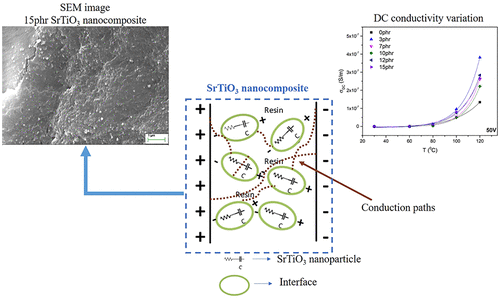当前位置:
X-MOL 学术
›
ACS Appl. Energy Mater.
›
论文详情
Our official English website, www.x-mol.net, welcomes your
feedback! (Note: you will need to create a separate account there.)
SrTiO3/Epoxy Nanodielectrics as Bulk Energy Storage and Harvesting Systems: The Role of Conductivity
ACS Applied Energy Materials ( IF 5.4 ) Pub Date : 2019-12-26 00:00:00 , DOI: 10.1021/acsaem.9b01953 Georgia C. Manika 1 , Georgios C. Psarras 1
ACS Applied Energy Materials ( IF 5.4 ) Pub Date : 2019-12-26 00:00:00 , DOI: 10.1021/acsaem.9b01953 Georgia C. Manika 1 , Georgios C. Psarras 1
Affiliation

|
Composite nanodielectric materials with strontium titanate nanoparticles embedded within an epoxy resin matrix were prepared and studied, varying the filler content. Broadband dielectric spectroscopy was employed for determining the dielectric response of the prepared specimens. Dielectric results reveal the presence of three relaxations processes, which are attributed to (a) glass to rubber transition of the polymer matrix (α-mode), (b) rearrangement of polar side groups (β-mode), and (c) interfacial polarization between systems’ constituents. The stored and harvested energy of the examined nanodielectrics was also evaluated under DC conditions in the applied voltage range of 10–240 V. The coefficient of energy efficiency (neff) was determined for all filler’s content, varying the applied temperature and field. The effect of temperature appears to be pronounced, causing a sigmoidal dependence of neff. Furthermore, filler content enhances neff, reaching the highest value of 69.41% for the 10 phr SrTiO3 nanocomposite at 50 V. Finally, both AC and DC conductivities were evaluated as a function of filler and temperature, and the corresponding activation energies were calculated. Hopping conductivity appears to be the predominant conduction mechanism in all nanocomposite systems, since experimental data are in accordance with variable range hopping model.
中文翻译:

SrTiO 3 /环氧纳米电介质作为大容量储能和收获系统:电导率的作用
通过改变填料含量,制备并研究了钛酸锶纳米粒子嵌入环氧树脂基体的复合纳米介电材料。宽带介电谱用于确定所制备样品的介电响应。介电结果表明存在三种弛豫过程,这归因于(a)聚合物基体的玻璃到橡胶的转变(α-模式),(b)极性侧基的重排(β-模式)和(c)界面系统组成之间的两极分化。在施加直流电压10-240 V的直流条件下,还评估了被检查的纳米电介质的存储和收获的能量。能量效率系数(n eff确定了所有填料的含量,并改变了施加的温度和场强。温度的影响似乎很明显,引起了n eff的S形依赖。此外,填料含量提高了n eff,在50 V下10 phr SrTiO 3纳米复合材料的最高值达到69.41%。最后,评估了交流电导率和直流电导率随填料和温度的变化,并计算了相应的活化能。跳变电导率似乎是所有纳米复合材料系统中的主要传导机制,因为实验数据符合可变范围跳变模型。
更新日期:2019-12-26
中文翻译:

SrTiO 3 /环氧纳米电介质作为大容量储能和收获系统:电导率的作用
通过改变填料含量,制备并研究了钛酸锶纳米粒子嵌入环氧树脂基体的复合纳米介电材料。宽带介电谱用于确定所制备样品的介电响应。介电结果表明存在三种弛豫过程,这归因于(a)聚合物基体的玻璃到橡胶的转变(α-模式),(b)极性侧基的重排(β-模式)和(c)界面系统组成之间的两极分化。在施加直流电压10-240 V的直流条件下,还评估了被检查的纳米电介质的存储和收获的能量。能量效率系数(n eff确定了所有填料的含量,并改变了施加的温度和场强。温度的影响似乎很明显,引起了n eff的S形依赖。此外,填料含量提高了n eff,在50 V下10 phr SrTiO 3纳米复合材料的最高值达到69.41%。最后,评估了交流电导率和直流电导率随填料和温度的变化,并计算了相应的活化能。跳变电导率似乎是所有纳米复合材料系统中的主要传导机制,因为实验数据符合可变范围跳变模型。










































 京公网安备 11010802027423号
京公网安备 11010802027423号